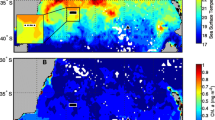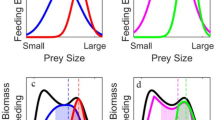Abstract
Measurements of the defecation rate of Salpa thompsoni were made at several stations during two cruises west of the Antarctic Peninsula in 2004 and 2006. Rates were quantified in terms of number of pellets, pigment, carbon and nitrogen for a wide size range of both aggregate and solitary salps. Measured defecation rates were constant over several hours when salps were held at near-surface conditions from which they had been collected. The defecation rate per salp increased with both salp size and the ambient level of particulate organic matter (POM) in the upper water column. The weight-specific defecation rate ranged between 0.5 and 6% day−1 of salp body carbon, depending on the concentration of available particulate matter in the water. Carbon defecation rates were applied to biomass estimates of S. thompsoni to calculate daily carbon defecation rates for the populations sampled during the two cruises. Dense salp populations of over 400 mg C m−2 were calculated to produce about 20 mg C m−2 day−1, comparable to other major sources of vertical flux of organic material in the Southern Ocean. Measured sinking rates for salp fecal pellets indicated that the majority of this organic material could reach deep sediments within a few days, providing a fast and direct pathway for carbon to the deep ocean.







Similar content being viewed by others
References
Andersen V (1986) Effects of temperature on the filtration rate and percentage of assimilation rate of Salpa fusiformis Cuvier (Tunicata: Thaliacea). Hydrobiologia 137:135–140
Andersen V (1998) Salp and pyrosomid blooms and their importance in biogeochemical cycles. In: Bone Q (ed) The biology of pelagic tunicates. Oxford University Press, Oxford, pp 125–137
Andersen V, Nival P (1988) A pelagic ecosystem model simulating production and sedimentation of biogenic particles: role of salps and copepods. Mar Ecol Prog Ser 44:37–50
Atkinson A, Siegel V, Pakhomov EA, Rothery P (2004) Long-term decline in krill stock and increase in salps within the Southern Ocean. Nature 432:100–103
Bone Q, Carre C, Chang P (2003) Tunicate feeding filters. J Mar Biol Ass UK 83:907–919
Bruland KW, Silver MW (1981) Sinking rates of fecal pellets from gelatinous zooplankton (salps, pteropods doliolids). Mar Biol 63:295–300
Caron DA, Madin LP, Cole JJ (1989) Composition and degredation of salp fecal pellets: implications for vertical flux in oceanic environments. J Mar Res 47:829–850
Casareto B, Nemoto T (1986) Salps of the Southern Ocean (Australian Sector) during the 1983–84 summer, with special reference to the species Salpa thompsoni, Foxton 1961. Mem Natl Polr Res 40:221–239
Chiba S, Ishimaru T, Hosie GW, Wright SW (1999) Population structure change of Salpa thompsoni from austral mid-summer to autumn. Polar Biol 22:341–349
Collier R, Dymond J, Honjo S, Manganini S, Francois R, Dunbar R (2000) The vertical flux of biogenic and lithogenic material in the Ross Sea: moored sediment trap observations 1996–1998. Deep Sea Res Pt II 47:3491–3520
Dagg MJ, Urban-Rich J, Peterson JO (2003) The potential contribution of fecal pellets from large copepods to the flux of biogenic silica and particulate organic carbon in the Antarctic Polar Front region near 170°W. Deep Sea Res Pt II 50:675–691
Dubischar CD, Bathmann UV (2002) The occurrence of faecal material in relation to different pelagic systems in the Southern Ocean and its importance for vertical flux. Deep Sea Res Pt II 49:3229–3242
Ducklow HW, Baker K, Martinson DG, Quetin LB, Ross RM, Smith RC, Stammerjohn SE, Vernet M, Fraser W (2007) Marine pelagic ecosystems: the West Antarctic Peninsula. Phil Trans R Soc B 362:67–94
Fischer G, Gersonde R, Wefer G (2002) Organic carbon, biogenic silica and diatomn fluxes in the marginal winter sea-ice zone and in the Polar Front Region: interannual variations and differences in composition. Deep Sea Res Pt II 49:1721–1745
Fortier L, Le Fèvre J, Legendre L (1994) Export of biogenic carbon to fish and to the deep ocean: the role of large planktonic microphages. J Plankt Res 16:809–839
Foxton P (1966) The distribution and life-history of Salpa thompsoni Foxton with observations on a related species, Salpa gerlachei Foxton. Disc Rep 34:1–116
Froneman PW, Pakhomov EA, Balarin MG (2004) Size-fractionated phytoplankton biomass, production and biogenic carbon flux in the eastern Atlantic sector of the Southern Ocean in late austral summer 1997–1998. Deep Sea Res Pt II 51:2715–2729
Hamner WH (1975) Underwater observations of blue-water plankton: logistics, techniques, and safety procedures for divers at sea. Limnol Oceanogr 20:1045–1051
Harbison GR, McAlister VL (1979) The filter-feeding rates and particulate retention efficiencies of three species of Cyclosalpa (Tunicata: Thaliacea). Limnol Oceanogr 24:517–528
Haddock SHD, Heine JN (2005) Scientific blue-water diving. California Sea Grant College Program Report No. T-057
Honjo S (1990) Particle fuxes and modern sedimentation in the polar oceans. In: Smith WO (ed) Polar oceanography, vol. II. Academic Press, New York, pp 322–353
Honjo S, Francois R, Manganini S, Dymond J, Collier R (2000) Particle fluxes to the interior of the Southern Ocean in the Western Pacific sector along 170 W. Deep Sea Res Pt II 47:3521–3548
Huntley ME, Sykes PF, Marin V (1989) Biometry and trophodynamics of Salpa thompsoni foxton (Tunicata: Thaliacea) near the Antarctic Peninsula in austral summer, 1983–1984. Polar Biol 10:59–70
Iseki K (1981) Particulate organic matter transport to the deep sea by salp fecal pellets. Mar Ecol Prog Ser 5:55–60
Kremer P, Madin LP (1992) Particle retention efficiency of salps. J Plankt Res 14:1009–1015
Loeb V, Siegel V, Holm-Hansen O, Hewitt R, Fraser W, Trivelpiece W (1997) Effects of sea-ice extent and krill or salp dominance on the Antarctic food web. Nature 387:897–900
Longhurst AR, Harrison WG (1989) The biological pump: profiles of plankton production and consumption in the upper ocean. Prog Oceanogr 22:47–123
Madin LP (1974) Field observations on the feeding behavior of salps (Tunicata: Thaliacea). Mar Biol 25:143–147
Madin LP (1982) Production, composition and sedimentation of salp fecal pellets in oceanic waters. Mar Biol 67:39–45
Madin LP, Cetta CM (1984) The use of gut fluorescence to estimate grazing by oceanic salps. J Plankt Res 6:475–491
Madin LP, Diebel D (1998) Feeding and energetics of Thaliaceans. In: Bone Q (ed) The biology of pelagic tunicates. Oxford University Press, Oxford, pp 125–137
Madin LP, Kremer P (1995) Determination of the filter-feeding rates of salps (Tunicata, Thaliacea). ICES J Mar Sci 52:583–595
Madin LP, Purcell JE (1992) Feeding, metabolism, and growth of Cyclosalpa bakeri in the subarctic Pacific. Limnol Oceanogr 37:1236–1251
Madin LP, Purcell JE, Miller CB (1997) Abundance and grazing effects of Cycosalpa bakeri in the subarctic Pacific. Mar Ecol Prog Ser 157:175–183
Madin LP, Kremer P, Wiebe PH, Purcell JE, Horgan EH, Nemazie DA (2006) Periodic swarms of the salp Salpa aspera in the slope water off the NE United Staes: biovolume, vertical migration, grazing and vertical flux. Deep Sea Res I 53:804–819
Masque P, Isla E, Sanchez-Cabeza JA, Palanques A, Bruach JM, Puig P, Guillen J (2002) Sediment accumulation rates and carbon fluxes to bottom sediments at the Western Bransfield Strait (Antarctica). Deep Sea Res II 49:921–933
Matsueda H, Handa N, Inoue I, Takano H (1986) Ecological significance of salp fecal pellets collected by sediment traps in the Eastern North Pacific. Mar Biol 91:421–431
Morris RJ, Bone Q, Head R, Braconnot JC, Nival P (1988) Role of salps in the flux of organic matter to the bottom of the Ligurian Sea. Mar Biol 97:237–241
Nishikawa J, Tsuda A (2001) Diel vertical migration of the tunicate Salpa thompsoni in the Southern Ocean during summer. Polar Biol 24:299–302
Pakhomov EA (2002) Salp/krill interactions in the Southern Ocean: spatial segregations and implications for the carbon flux. Deep Sea Res II 49:1881–1907
Pakhomov EA (2004) Salp/krill interactions in the eastern Atlantic sector of the Southern Ocean. Deep Sea Res II 51:2645–2660
Pakhomov EA, Perissinotto R, McQuaid CD (1994) Comparative structure of the macrozooplankton/micronekton communities of the Subtropical and Antarctic Polar Fronts. Mar Ecol Prog Ser 111:155–169
Pakhomov EA, Dubischar CD, Strass V, Brichta M, Bathmann UV (2006) The tunicate Salpa thompsoni ecology in the Southen Ocean. I. Distribution, biomass, demography and feeding ecophysiology. Mar Biol 149:609–623
Perissinotto R, Pakhomov EA (1998) The trophic role of the tunicate Salpa thompsoni in the Antarctic marine ecosystem. J Mar Syst 17:361–374
Schnack-Schiel SB, Isla E (2005) The role of zooplankton in the pelagic-benthic coupling of the Southern Ocean. Sci Mar 69:39–55
Strickland JDH, Parsons TR (1972) A practical handbook of seawater analysis, 2nd edn. Bull Fish Res Bd Can 167
Suzuki H, Sasaki H, Fukuchi M (2001) Short-term variability in the flux of rapidly sinking particles in the Antarctic marginal ice zone. Polar Biol 24:697–705
Turner JT (2002) Zooplankton fecal pellets, marine snow and sinking phytoplankton blooms. Aquat Microb Ecol 27:57–102
Wiebe PH, Madin LP, Haury LR, Harbison GR, Philbin LM (1979) Diel vertical migration by Salpa aspera and its potential for large-scale particulate organic matter transport to the deep sea. Mar Biol 53:249–255
Acknowledgments
We wish to thank the many people who worked in support of this project as divers, laboratory assistants and technicians. Included in this group are Erich Horgan, Jeff Godfrey, Jeff Mercer, Kerri Scolardi, Wally Fulweiler, Kelly Rakow and Sandy and Izzie Williams. We are grateful to the crew of the ASRV Laurence M. Gould for their support and the comments of three anonymous reviewers. This study was funded by NSF grants OPP-0338290 to P. Kremer and OPP-0338090 to L. Madin.
Author information
Authors and Affiliations
Corresponding author
Additional information
Communicated by X. Irigoien.
Rights and permissions
About this article
Cite this article
Phillips, B., Kremer, P. & Madin, L.P. Defecation by Salpa thompsoni and its contribution to vertical flux in the Southern Ocean. Mar Biol 156, 455–467 (2009). https://doi.org/10.1007/s00227-008-1099-4
Received:
Accepted:
Published:
Issue Date:
DOI: https://doi.org/10.1007/s00227-008-1099-4




